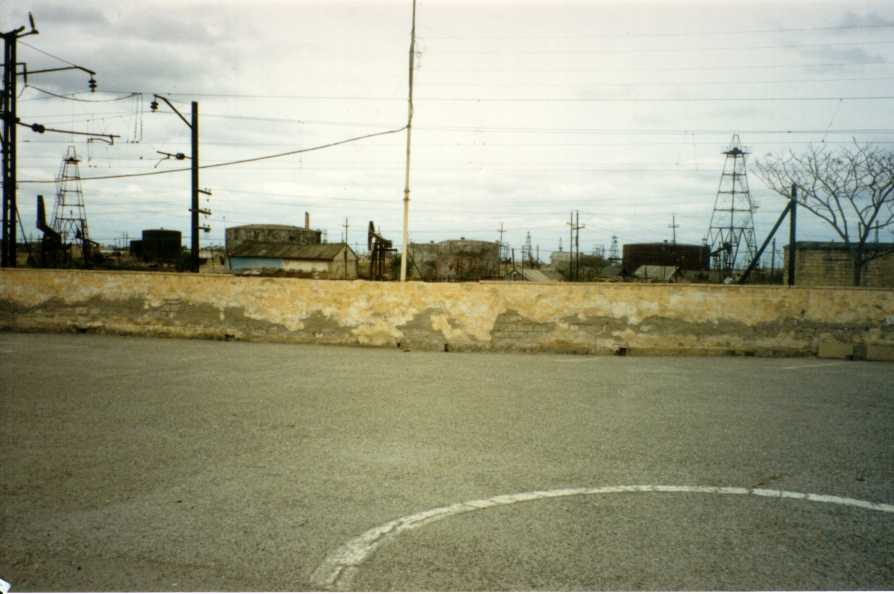
In 1995, oilfields still surround the Baku temple |
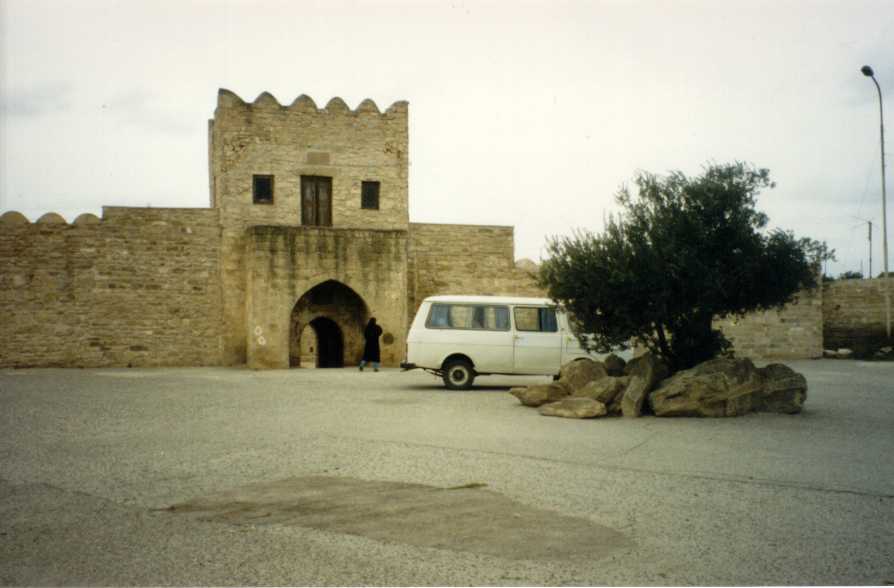
Main entrance to the Baku temple |
| Avesta -- Zoroastrian Archives | Contents | Prev | baku | Next | Glossary |
This book written in Gujarati by Dr. Modi was published in 1926 describing his extensive travels from Mumbai to Aden to Africa, Europe, Russia, Iran, Iraq, Karachi, and back to Bombay in 1925. His major objective was to travel to all these places in search of clues about Zoroastrian civilization which was spread in many dynasties from Europe to China and all the way south to India, ending with the Sassanian Dynasty’s glorious empire destroyed by Arabs in 7th century.
The main reason I am interested in translating pieces of this book is how he connects our religious texts, prayers, etc. with the cities, historical places, etc. he visits. I am not a scholar of any language, let alone Gujarati; however, I have endeavored to translate these pieces with the best of my knowledge and efforts with a hope that others less fortunate not to know Gujarati will benefit from it.
I want to first acknowledge the help of my good friend Jamshid Zartoshty, Minsk, Belarus, who was the first person who pointed out to me this book and some interesting facts about the Atash-Kadeh of Baku, Azerbaijan, described by Sir Modi in this book. He wanted to have pages 266-276 to be scanned from the book and sent to him for one of his friends. I took up his request and ask for help of my nephews, Zarir Darbari and Cyrus Dastoor, to find out if we can get hold of this book, and if so, can Zarir scan the above pages from it and send it to me so I can forward them to Jamshid. As always, Zarir persisted in following up on this request, consulted the newly ordained Dastoorji Peshotan Mirza, son of the famous late Dr. Hormazdyar Mirza, who approached Dastoorji Kaikhushroo Jamasp Asa, who in turn obtained a copy of the book from a library and loaned it to Zarir. Zarir then scanned the pages and send them to me which I forwarded to Jamshid.
However, this whole episode sparked my interest in the entire book and was amazed at the vastness of the travels of Sir Modi described in this book. He visited Aden, North Africa, France, UK, Germany, Hungary, Russia (U.S.S.R. at that time), Azerbaijan, Iran, Iraq, Turkey, and Karachi. Everywhere he went, he visited historical places and discussed religious and historical subjects with the local scholars, gave lectures in English, French, Persian, and connected a number of places with our Zoroastrian prayers, history, customs, etc.
The subject matter of Jamshid’s request is his description of his visit to Baku in Azerbaijan on the Caspian seashore where an ancient Atash-Kadeh was alleged to be existing. Hence, here is the English translation of this chapter from Sir Modi’s book, pages 266-276.
Soli Dastur, June 18, 2004.
The following additional information was supplied by Mr. Farroukh Jorat of the Russian Zarathushtrian web-site, along with photos of the "Qala-e Duxtar" and "Atashgah".
Dear sirs!
First of all I would like to thank mister Ramiyar Parviz Karanjia, who informed me about the memoirs of Dr. J. J. Modi; Dastoorji Peshotan Mirza and Dastoorji Kaikhushroo Jamasp Asa, who obtained a copy of the book from a library; Mr. Zarir Darbari, who scanned the pages from this book; Mr. Soli Dastur, who translated it from Gujarati in English and my friend Jamshid Zartoshti, who send me the translation of this book.
In this book Dr. J. J. Modi mistakenly wrote, that Fire Temple, which is known as Atashgah (in a settlement Suraxane near Baku) was Hindu Fire Temple of Jwalaajee (I have made photos of this Temple, and you can look at them here.
Earliest mention of the Zoroastrian worship of fire in Suraxane belongs to the Sassanid era. Armenian chroniclers in the description of Bhagavan (Baku) in the Paytakaran province on the Caspian coast mentioned "Seven sacred fire holes" and establishment of fire temples by Shah Ardashir I (227-241).
In 1683 a German traveler Kaempfer has visited Baku. He noted that there are seven fire holes in Suraxane, revered by descendants of the ancient Persians who migrated to India.
Later Atashgah was restored by Hindu people for their purposes, but along with them in the temple were present Zoroastrians too. Also you can see that the central altar is built in the Iranian style 'chahar taq' (4 arches inverted to North, South, East, and West).
Above the entrances of some of the cells are placed stone tablets with a brief dedicatory inscriptions: 14 Hindu, two Sikh and one Persian (Zoroastrian) inscription. You can read about it here.
The other temple of fire described by Dr. Modi is today referred to as the Maiden tower ("Qala-e Duxtar"). I send its photo. You can read about it here.
In his book Dr. Modi requested to inform him of any archeological studies which shed some light on Zoroastrian culture. And only 31 years later after Dr. Modi's death near the "Qala-e Duxtar" archaeologists found one more altar of fire worship with stone cup, where the petroleum was filled in. I also have article about it and I'll try to translate it.
With best regards,
Farroukh Jorat,
Baku, Azerbaijan
“Hamajor zareh varkash” Afrin e Haft Ameshaspand
Meaning: Hamazor with Vourukash Sea!
With the grace of God (Khudaa Taalaa), on 24th September 1925, I stepped on the holy land of Azerbaijan in Iran for the first time. I thank Ahura Mazda (Daadaar) for making it possible for me to visit this country. I left Tiflis city after midnight of 23rd September and after about a journey of 16 hours, I arrived at Baku at 5 P. M. next day, 24th September. About two to three hours before arriving in Baku, I first saw the vast seashore of the Vourukash Sea (Caspian Sea). In all my lifelong prayers of Afringan, I have made Hamazor many a time with this sea, reciting the above sentence. Now, I am seeing this sea by my own eyes. To celebrate this momentous occasion, I did my Kusti and daily morning (Haavan Gaah) prayers and recited Avan Ardvisur Nyayesh and paid homage to this sea with many thanks to Ahura Mazda (Khudaa Taalaa).
From Moscow, I spent 2 nights in the train, one night in Vladivostok city on an uncomfortable sofa in its Agricultural Institute, since there was no place in the local hotel, and a very short 4th night in Tiblis since I had to make arrangements for my visit to Baku late into the night. That night, I went to bed at 1 A. M. and had a few hours of sleep. I spent the fifth night in train again. Thus, I was exhausted when we arrived finally in Baku on the afternoon of the fifth day, took early dinner and went to bed at 8 P. M. so as to be ready next day at 7 A. M. to visit the Atash-Kadeh of Baku.
In Baku, Russian and Turkish were the only languages spoken by the people. Rarely, someone speaks Farsi. For this visit in Baku, I had approached the Iranian Consul of Tiflis and requested him to wire someone in Baku so as to have someone receive me there when I arrive. He had done so and I was indebted to him for this help. Because of this request, a Baku Consulate person was there to receive me at the station and took me to this hotel. The Iranian Charge des affairs in London have given me a very complimentary endorsement letter which resulted in these arrangements for me in Baku.
The same gentleman agreed to pick me up next morning to take me for a visit of the well-known Baku’s Atash Kadeh. But he never showed up. After waiting for him a long time, I requested the hotel management to find me a guide. One of the hotel guests who knew some French kept telling me: “He will come. He will come.” Well, I waited the whole morning, the day’s cooler time, for the gentleman. As I was wondering what to do now, just then a young man, who could speak a little English, came from outside and asked: “Are you Dr. Modi?” After hearing in the affirmative from me, he informed me with the great happiness: “I am representing the local Azerbaijan Exploration Society. Our Society heard about you arriving from Tiflis and so we wired the President there to invite you here on our behalf and send you here to us. We received the answer that you have already left Tiflis. We did not know which train you will be catching from Tiflis. Hence, I have been searching for you in a few local hotels and finally I came to this hotel.” With the grace of Ahura Mazda, my worries were unexpectedly over and I now had a noble guide who took me under his wings as an honored guest of the Society. Immediately, he called three four important members of the Society and within a short time escorted me to the office of the Society. There, we had a discussion with these members about the Parsees and about the local alleged Atash Kadeh. They were also very interested in the History of the Hun people. Recently, they came in contact with a Hun group. Afterwards, one of the members accompanied me to my hotel room. There he saw my book: Asiatic Papers Part III and examined it for a while and opened the book on the subject: The History of the Hun People and placed his hand on that page and said: “This subject is very important to us.” I promised him that I will send a copy of the book to him after I returned to Bombay.
Now in the office of the Society, we decided that I should first visit Baku’s Atash Kadeh and then at about 8 P. M. I should give a lecture to the Society members whoever can attend. Two specific subjects were decided for my lecture. One about the Parsees and the other about the Ancient History of the Hun people. After that, these noble people escorted me in two cars to visit Baku’s Atash Kadeh.
The Atash Kadeh was in a place called Surkhani on the road from Baku about 30 to 45 minutes by car. Traveling from Tiflis to Baku, one will pass miles and miles of barren country. Except for a few small one to two feet tall shrubs, grazed by feeble looking animals, there was no sign of any tree. Similar to an oasis within a desolate desert, the skyline of this Surkhani seemed to have hundreds of tall cypress trees; however, as we approached closer to it, they were not the trees but tall wooden structures of the petroleum wells, many of them from 50 to 75 feet tall. They call this place “Surkhani”. The origin of this word may have come from “SHO-E-LE-KHANEH” meaning the house (“KHANEH”) of the fire balls (“SHO-E-LE”). Among the ocean of these petroleum wells is situated this alleged Atash Kadeh. Not just me but any Parsee who is a little familiar with our Hindu brethren’s religion, their temples and their customs, after examining this building with its inscriptions, architecture, etc., would conclude that this is not a Parsee Atash Kadeh but is a Hindu Temple, whose Brahmins (priests) used to worship fire (Sanskrit: Agni).

In 1995, oilfields still surround the Baku temple |

Main entrance to the Baku temple |
About hundred to two hundred years ago, our Hindustan (India) used to have a very good trade with the Central Asian cities like Samarkand, Bokhara, etc. Also, many Hindu traders from Hindustan used to visit Baku for trade. North Indian Hindu traders from Sindh and Multan (now in Pakistan) used to take part in this trade and used to visit Baku. This temple was erected to satisfy their religious needs. Our Hindu brethren also consider Fire (“Agni”) as a God. The natural gases emit from earth at this place, which will ignite into a continuous fire ball by any sparks. Hence here at the mouth of fire naturally originating from earth, they established a Hindu Temple for fire worship. After a few years, the original trade routes and customs changed and the visits of the Hindu traders diminished. And from the original group of the Brahmins, some passed away and a few that were left went back to their original home land. At this place, they showed me a long room and informed me that some 40 years ago, the Russian Czar, Alexander III, visited this place with a desire to witness the Hindu Brahmin Fire ritual. So the local officials gathered a few Brahmins still living here and they performed the fire ritual in this room in front of the Czar.
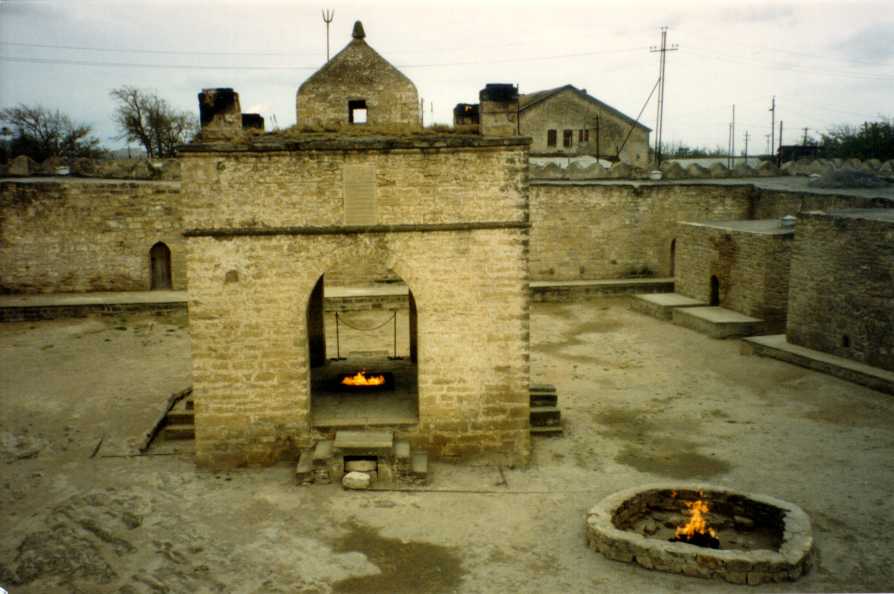
So-called Atashgyakh |

Tableaux 1: A depiction of a Hindu ceremony |
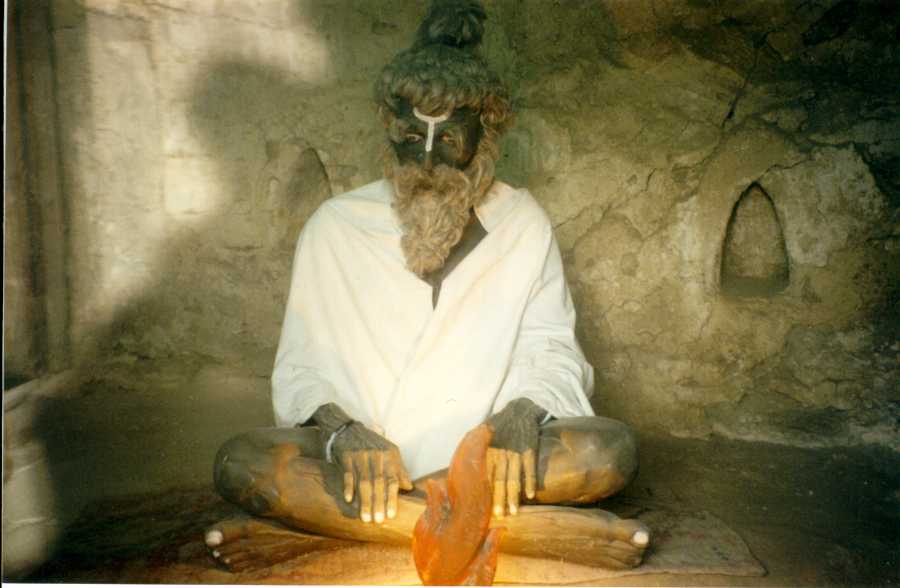
Tableaux 2 |
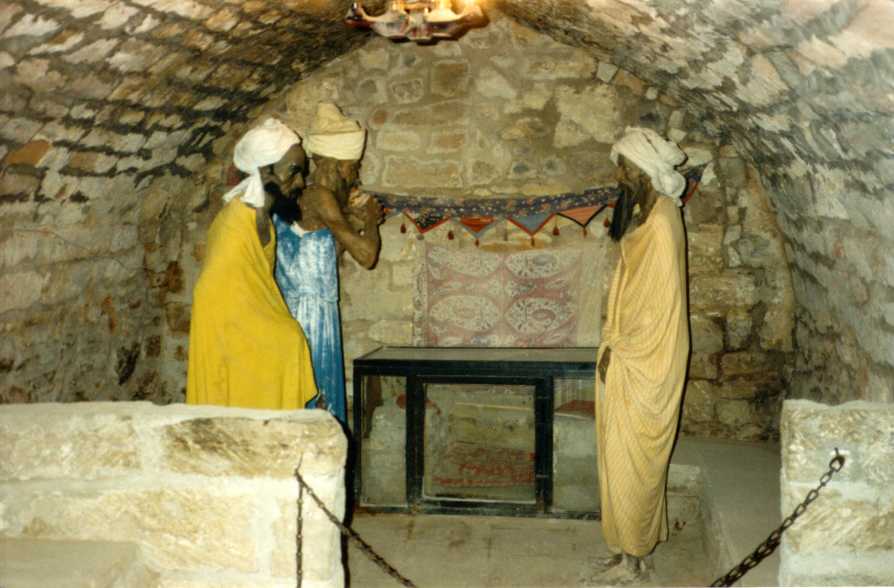
Tableaux 3 |
I spent two hours inspecting this place. I asked for a tall ladder and with trepidation I climbed to the top of the building and examined the foundation stone which was inscribed in the Nagrik [or Nagari] script (the Sanskrit language; the most common Hindu characters of writing). I also examined the small living rooms (cells), adjacent to the main square of this building, which resembled the Indian Buddhist monasteries cells for their monks. I also examined the place where they used to cremate bodies of the dead Hindus. And from all these examinations, in addition to what I believed from my various research before visiting this place, I became convinced that this place has nothing to do with Parsees. It is not a Parsee Atash Kadeh but a Hindu Temple.
This building is about 15 to 18 feet square. In the center is a pit about 2 to 3 feet deep and about 4 feet square, similar to the pit our Hindu brethren would dig for their “Haoma” (or Soma) ritual. Due to the natural gas emitting from this pit, the fire could have been lighted. Above is a dome; however, it is not round (circular) as in a Parsee Atash Kadeh. But, in the center of the dome, there is a big opening from which natural sunlight will shine in the pit. In a Parsee Atash Kadeh, stringent care is taken to ensure that no natural sunlight shines directly on the holy fire in the sanctum sanctorum. On the four sides of this building, port holes have been provided for the smoke to escape.
At the entrance of the building, there is a foundation stone with inscription in Nagrik script, which in the beginning invokes the Hindu God, Shree Ganesha. The building is referred to in the inscription as “JWAALAAJEE” (meaning volcanic), that means some burning substance building. And the installation date is mentioned as the Hindu Vikramaajeet calendar year 1866 (equivalent to 1810 A. D.). This inscription contains nine lines and the pictures drawn in this inscription are as follows: the first row has a flower first, then a bell (“GHANT”), then the sun, then a fire ball, and again a fruit. The second row below this has a flower first, then the trident of Lord Shiva (“TRISHOOL”), then the Swastika symbol (Hindu style), then a second trident and then a flower. It was impossible to write all this down as I was deciphering the inscription at the top of a trembling ladder. Hence, I spent some time in noting all the details of the inscription mentally and then writing them down after coming down to the floor. In the inscription, you see: “SHREE GANESHAAYANUM” in the first line, the Vikramaajeet Hindu calendar year (“Vikramaajeet Saake”) in the second line and “Shree Jwaalaajee” (the fire ball) in the third line.
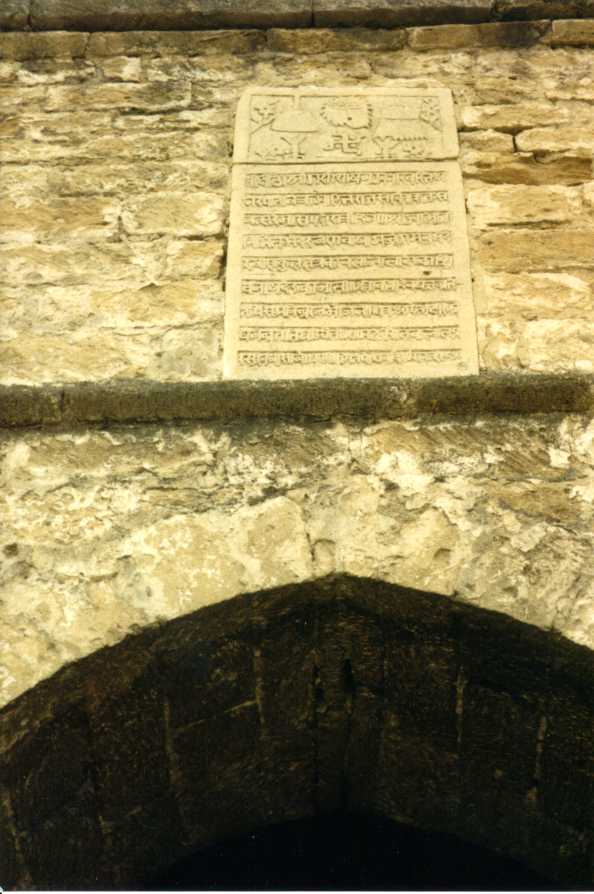
Sanskrit inscription above main entrance |
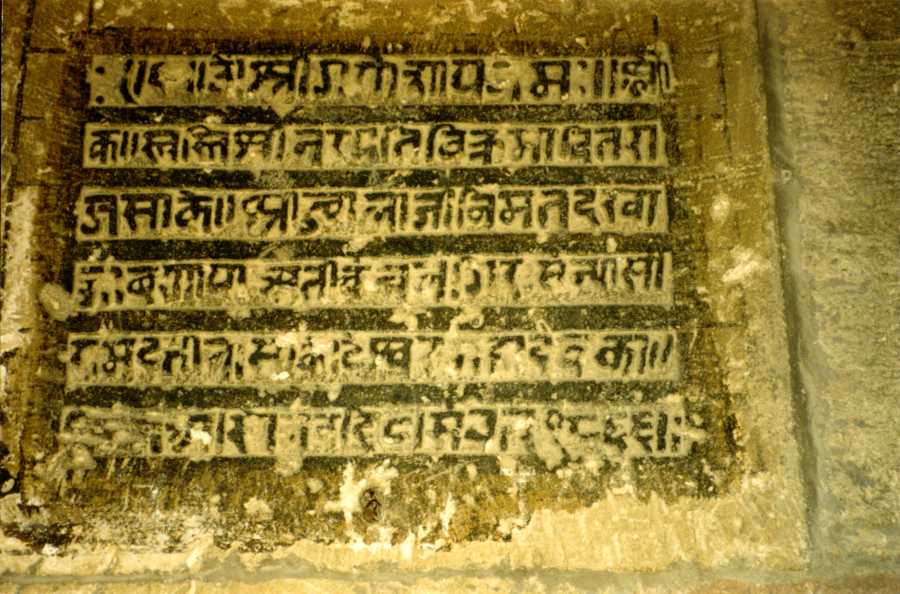
Another inscription
Yet another inscription |
On all four sides of this building are small minarets. They are open on all four sides and there are three steps on all four sides. Some years back when there were Parsees and other communities living here, then a Parsee Atash Kadeh would not be left open for all to see. In the center, there is a pit. In a Parsee Atash Kadeh, for the central fire, a high platform like a throne is erected. Near this building, there is a place about 8 to 10 feet long where they say that the Hindus used to cremate their dead. This will never happen in a Parsee Atash Kadeh.
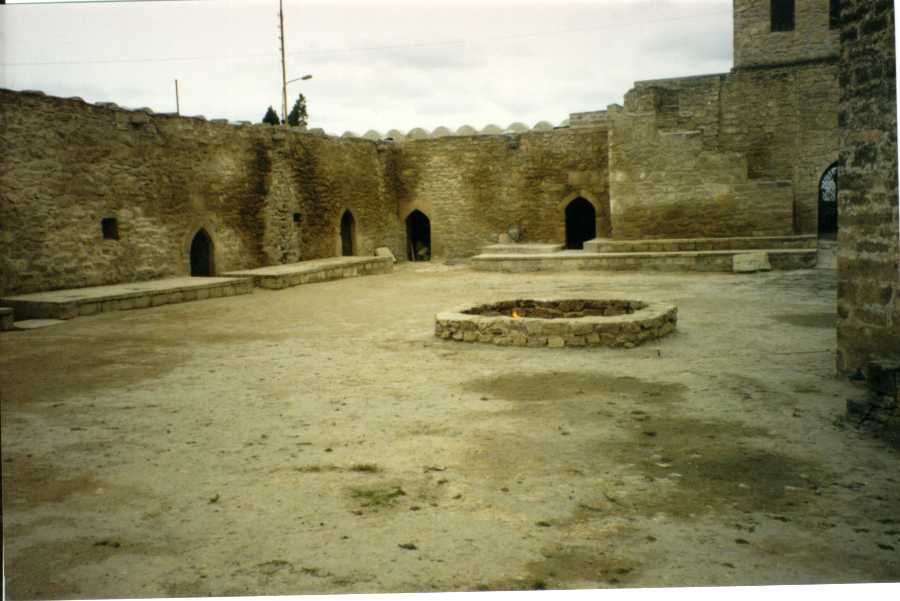
View of courtyard showing alleged cremation pit |
In the main square, there are ruins of what seems like a small temple. Such ruins are also on the other side. Both have been leveled to ground. One has been restored by the Government. It seems that a rich follower may have built them.
Around the temple there is a large square where a number of small cells are erected in a row. They are closed from outside and so appears to be a compound wall from outside. Every cell has a door but no windows. There are 25 of such cells. In one of them is a wall painting of Hindu God, Ganesha. Some walls have pictures of trees and Trident. One of these cells is about 35 feet long. May be it was a common dormitory for visitors and faithful. Some cells have a dome like structure at the top. Two cells were used to tie up the horses of the visitors. In about nineteen cells, there are inscriptions in Naagrik script. From these inscriptions, it can be deduced that traveling faithful may have built these cells. One inscription is in Farsi whose date is given as 1158 Hijree; that means that this Farsi inscription was inscribed 190 years ago (about 1735 A. D.). From this Farsi inscription it appears that when Baku, and the whole Azerbaijan, was under the suzerainty of the Shah of Iran, the influence of Farsi was very important in this area. This date is older than the date on the foundation stone inscription of the Hindu Temple (1810 A. D.) which proves the Hindu Temple was built later on. Some parts of this Farsi inscription are damaged. First line: “Aatash saf kashideh humchoo del” is readable. So also the Hijree date mentioned above.
From all the above facts it is without a doubt clear that this building is not a Parsee Aatash Kadeh. Before coming here, from my research in reading various articles, I was sure then that this building is not a Parsee Aatash Kadeh.
A question has been repeatedly raised if this building is a Parsee Aatash Kadeh or it is a temple of the Hindus who also worship fire. About 25 to 30 years ago, when the Gujarati Knowledge Spreading Society celebrated its Golden Jubilee by convening a “Conversazione”, I rented a stall and exhibited a number of Iranian artifacts and books, as well as a picture of this Baku Aatash Kadeh and informed the visitors that it is not a Parsee Aatash Kadeh. That time I also printed a handbill to explain this conclusion. My friend, Mr. Nusserwanjee Heerjeebhai Patel, who is very meticulous in preserving the old documents of this Society, may still have a copy of this handbill. Afterwards, in the Times of India newspaper, this subject was again opened for debate when I also published a number of facts on this subject. In this, I have used the supporting reference from the famous Central Asian traveler, Dr. Swen Hedin, whom I met in Stockholm in 1889 A. D., who gave me a copy of his essay on this Baku Aatash Kadeh. I also remember that Sir Dinshaw Eduljee Vaachhaa, who besides politics also took great interest in such matters of history and literature, wrote a letter to me agreeing with my facts on this matter that the building is not a Parsee Aatash Kadeh but a Hindu Temple.
This was the main question which brought me to Baku. The major reason why I did not go from Tiflis by train straight to the southern parts of Azerbaijan which are more important for our religion than this northern part of Azerbaijan was to visit this place. Also, I wanted to visit the Durburn Wall of Noshirwan-e-Aadel.
When I visited the Kangra Valley in the Himalaya Mountains some 25 years ago (1900 A. D.), I was told that the current Aatash Kadeh was considered as a Hindu Temple by the Hindu friends I met there. In the year 1900 A. D., I was not well from the after effects of the Cholera I contracted years ago. Hence, I traveled with my relative, Jamshedjee Eruchjee Modi, to the hill town of Dharamshalla in Punjab as guests of his relatives Faraamroj and his brother Naadirshaw Khajooree, for rest and change of climate. After a few days of rest and relaxation, we visited the valleys of Kangra and Kulu by the way of Paalanpoor and Baeznaath. That time I heard that there is a village called Jwaalaajee where at one place natural gas emits from earth, night and day, and the Hindu worshippers throw clarified butter (Ghee) on it so that the fire lights up like a huge fire ball. I went there after hearing about it and saw the place of this burning substance (Jwaalaajee). Talking to the Hindus there, they call this Small Jwaalaajee and stated that their Big Jwaalaajee is in Baku, Aazerbaizaan.
On 18th September 1925, I visited Lenin Museum in Moscow. In this museum were shown full sized statues of the people of various countries of U. S. S. R. This is a very worthwhile collection to see. In it were also the statues of devotees in olden times of the Baku Temple. They were shown creating fire from wood and sitting cross legged around fire. Some are shown coming from the front to do the fire worship (“Poonjaa”) with musical instruments. They have red dots (“Tilaks”) on their foreheads. Some are shown weaving a rug. It has an explanatory tablet in Russian in which they are identified as Hindus. The Russian woman custodian near this exhibit gave me the following English translation (as given in the book in English and reproduced verbatim here):
“Near the town Baku in the villages of Souratshaanaa and Emidjan where the fire (naphtha) comes from the earth lived the Hindoos, who came from India. They were Brahmans. They made a temple and adored the fire many years. They lived there, but now they are not at Baku. It is said then years before they lived in little rooms and worked for money. They built their cells. They are not the Parsees - the Guebers who adored Zarathushtra”.
In the museum’s catalog, the following description is given about this exhibit in Russian which was translated in English as follows (as given in the book in English and reproduced verbatim here):
“A Russian traveler Beresine relates that the temple has the form of 5 sides. In the middle of these five sides’ place, there was a little well a long tube-like hole and the naphtha came out of it and the temple has a little bell and the worshipper begins the prayers, the bell is rung. This little room is covered with a cupola and near the door a trident symbol of Shiva. The inscription on the door says that the temple was built in 1866 (Russian 1810). Near the temple is a large pit. Over it is a great stove. On the stove all the dead are burnt. In 1842 there were only seven persons and afterwards nobody came from India.”
The custodian woman of the exhibit read the catalog: “The Description of the Collections in the Ethnographical Museums”, which was compiled by a local scholar, Professor Miller, in Russian and translated it into English for me which I wrote down and presented it here, with a hope that some Hindu scholars may find it useful to know how their religious rituals were performed about hundred years ago outside their country.
About 20 years ago in 1905, an authentic big book, Baku by J. Henry, was published. In it, it is erroneously stated that the building was a Parsee Aatash Kadeh. It states:
“When 25 years ago, the priestly attendant - a Parsee from India and the last of the long list of Fire-worshippers reaching 2500 years died at Surkhani.”
I believe that as far as Parsees are concerned, they should completely remove the notion that the building in Baku is a Parsee Aatash Kadeh. A scholar who has burnt a little or lot of midnight oil, as the saying goes, over a small or a large historical place, when he visits that place and sees it with his own eyes, and corroborates his previous opinion about that place must be overjoyed by that visit. The same was the case for me during my visit to Baku. In addition, I was very glad to see and learn new things.
Just because I have proven by my previous scholarly studies that this building is not a Parsee Aatash Kadeh and now after seeing it with my own eyes I can with certainty corroborate the same conclusion here, does not mean that in this city, in ancient times, there were no Aatash Kadehs. There may be more than one Aatash Kadehs in this city. In our ancient literary works, there are references of the worship of fire emitting directly from earth. In all the various types of fires, one fire has been described which burns without any fuel. This is the same fire of the natural gas wells which burns night and day without any fuel. One early Catholic priest in ignorance has described this phenomenon as the sleight of hands by a Parsee priest in making this fire burn continuously without fuel. But there is no sleight of hands in this. It is just a natural phenomenon.
We all pray at the end of each of the five Geh prayers the following prayer remembering various fires.
“Thwaam aatarem Ahura he Mazdaao puthrem ... yazamaide. ... Apaam Naptaarem Yazamaide. Nairim Sanghhem yazamaide.”
Meaning: "We venerate you Aatash, the son of Ahura Mazda. We venerate Apaam Naptaar Aatash. We venerate Nairyosangha Aatash."
In this veneration of Aatash, in "Apaam Naptaar" words, the word "Naptaar" is the root of the current word Naphtha. This Naphtha flows like a liquid and so its Aatash is called "Aap" meaning liquid. If I am not forgetting, for this comparison, Mr. Meherjeebhaai Paalanjee Maadon gave a talk on the subject in our Investigation Society for Zoroastrian Religion.
The origin of this country’s name, Azerbaijan, is from our own word “Aazar” or “Aatar” meaning fire, because in ancient times, there were a number of Aatash Kadehs in this country similar to the natural gas fire in Baku and in other places. One of our highest Aatash Behraam, Aadar Gushaspa, was also in this country whose other names were: “Aadarbaadgaan” or “Aataropaatkaan”. Hence, there should be a similar Aatash Kadeh in Baku. Ten miles from Baku, I described previously in this book, the “Kur”, “Kurus” (Cyrus) river which starts in Caucasus Mountains and empties in Caspian (Vourukash) sea. It has been stated in history that the Roman Emperor, Heraclius, ordered to destroy all Aatash Kadehs up to this river. The above mentioned writer, Mr. Henry, writes the following account about Baku, quoting from Gibbon:
"Heraclius encamped (?) on the steppes at the shores of the Kura, ten miles south of Baku. There Gibbon says ... At his command the soldiers extinguished the fires and the temples of the Magi. Twelve years later, Persia was vanquished a second time by the Arabs who at the edge of the sword converted the people from fire worship to the Musalman faith. Large numbers fled to Ormuz, thence to India and gave origin to what are now the Parsees of Bombay."
It is said that the Lithuanians, the U.S.S.R. neighbors, also used to visit Azerbaijan to worship these fires.
The real story behind Gibbon mentioning about the destruction (extinguishing) of the Baku’s Zoroastrian Aatash Kadehs at the hands of Heraclius is as follows: The Persian Emperor, Khushroo Perviz, attacked the holy Christian places in Palestine and carried with him to Iran the holy cross on which Jesus Christ was crucified. In revenge for carrying this Cross to Iran, this Roman Emperor destroyed the Iranian Aatash Kadehs.
Now there is a minaret here which is called “Kiskale” or Tour de la jeune fille in French, meaning Young Girl’s Minaret. There is a local legend, which is doubted by many, which states that one father wanted to marry his own daughter. The daughter made a deal with her father that: “If you build a tall minaret and when it is completed, I will marry you.” When the father completed the minaret, the daughter climbed at its top and fell off and committed suicide. Now my guide told me that this is not a true story and there was nothing to wonder about it. If the daughter did not want to marry her father, there were many ways she could have committed suicide. Moreover, this is not a simple minaret. In it there are seven stages or storeys or escape routes for the emission of Baku’s Naphtha. I examined the minaret all the way to its top. There at the top was a tablet in Farsi with the inscription: “Kooba-a-Masood bin Daaood”, meaning “House of Daaood’s son, Masood.” Now, some of the local people believe that this is a very ancient building, of Sassanian times or even older than that. And it was built as a copy of the ancient Babylonian Minarets. And about eight hundred years ago, one emperor, Masood, created this tablet to commemorate his name. If he himself had built it, he would have mentioned that in a foundation stone together with its Hijri (Muslim) date.
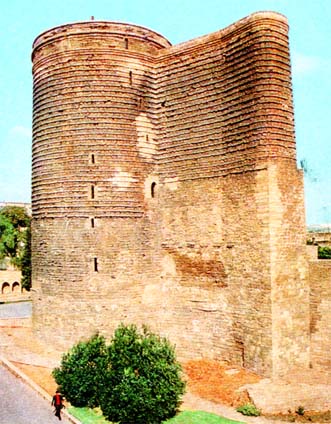
According to my examination, I think the above opinion is correct. This is an ancient Iranian building and it is an Aatash Kadeh. It is not a common Aatash Kadeh with its fire maintained by burning wood by its priests. But it is an Aatash Kadeh fed by the natural gases, Naphtha, (apaam Napaat). Haft or seven is a very holy number in Zoroastrian religion and hence there are seven storeys or stages in it. At each storey, in one corner, there is an escape hole for the natural gas Naphtha which when lit created a fire ball. This minaret is taller than 80 feet. The climbing steps are on one side and its diameter at the top is as large as forty feet. From the top, you can see the vast sea shore of Vourukash sea (Caspian sea), and from its ramparts you can observe the nature’s sun, moon, and stars.
Now, in our country, India, in the ruins of that famous ancient city of Taxila near Rawalpindi city, Sir John Marshall has excavated the ruins of an ancient Aatash Kadeh. I have commented about it before in this book, as well as I have spoken about it in my lecture on “Patliputra” (present day Patna, of the famous king Chandra Gupta of the Maurya dynasty). With this Aatash Kadeh, there was a tall minaret which was built according to the architecture and design of the ancient Babylon’s Ziakurut. An Aatash Kadeh with its adjoining minaret, from the top of which one can see the neighboring sea or river or lake and from its top one can observe the sun, moon, stars, and mountains and worship them, such was the design of ancient Aatash Kadehs. I have mentioned it before in this book that our Aatash Behraam in Navsaari is built according to the architecture of ancient Aatash Kadeh. Here in Baku, this minaret which was connected with Babylon by my guide is a combined Aatash Kadeh and minaret in this huge building. In fact, this was not a common Aatash Kadeh where fire was kept lit with sandalwood or dried wood, but was naturally lit by the natural gases of Naphtha (Apaam Napaat).

Altar at the Qala-e Duxtar, photograph courtesy of Mr. Farroukh Isfandzadeh of the Russian Zarathushtrian web-site http://blagoverie.org/eng/index.phtml. |
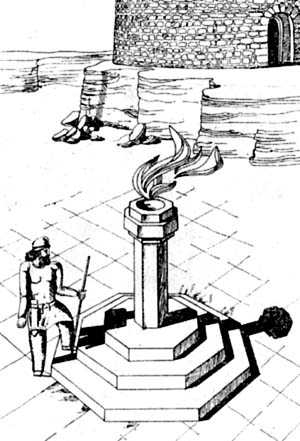
Reconstruction of altar, courtesy of Mr. Farroukh Isfandzadeh of the Russian Zarathushtrian web-site http://blagoverie.org/eng/index.phtml. |
In my humble opinion, on one hand I have discounted the existence of one Aatash Kadeh, supporting my previous studies on this subject; but on the other hand, I brought to light another ancient Aatash Kadeh, and for this, hopefully my visit to this place will be of some use to my colleagues. This could be one of the Aatash Kadehs destroyed by Heracleus, as reported by Gibbon, or according to the previous discussion, it may be one of the Aatash Kadehs destroyed later by Arabs. In my lecture here to the local scholars and the Archeological Society members, as well as during my meeting with the President of the Republic later on, I emphasized to all of them the importance of this Aatash Kadeh and implored them to take good care for its preservation.
I gave two lectures in Baku. As mentioned before, the first one was delivered on November 26th on the two subjects: “The Parsees” and “The Hun People”. The second one was delivered on November 28th at 8 P.M. and on the same night, I left Baku at 10 P.M. to travel to Tabriz. The first lecture was given in Farsi to the members of the local Exploration Society and was simultaneously translated in Turkish by a local member. Only one or two members can understand English and a few can understand Farsi and so it was necessary to translate it in Turkish because it is the spoken language of the local Muslim people.
I chose the subject for my second lecture as: “The Importance of Azerbaijan from a Parsee Point of View”. This lecture was publicized and was also mentioned in the local newspapers and hence the lecture hall was fully occupied. I also gave this lecture in Farsi which was simultaneously translated in both Russian and Turkish because many in the audience can understand only one of these two languages. My objective for this second lecture was to create an interest in our religion among the local learned people.
After the first World War, this north part of Azerbaijan became an independent Republic under the sovereignty of the U.S.S.R. After the Russian Revolution, the vast empire of the Russian Czars were divided into 24 smaller republics based on ethnicity and the whole country was called U.S.S.R. (United Soviet Socialist Republic) similar to the formation of U.S.A. Each U.S.S.R. republic elects its own President. Since many republics have Muslim majority, many Presidents of such Republics are Muslims. Here in Azerbaijan, due to Muslim majority, the elected President, Honorable Agamaliogly (age 60) is also a Muslim. He is a gentleman with an open mind. Because of physical problems with his legs, he could not attend my second lecture. However, he wanted to meet me on my last day in Baku and sent his personal car for me. After our meeting, I was happy on two accounts. First, I was able to make him really interested in our ancient Iranian culture; and secondly, I was able to know the details of the current political situation of his country. I brought to his attention the importance of the Aatash Kadeh with the minaret, which I believe was an ancient Aatash Kadeh and made a fervent appeal to him to preserve it in good condition. He was very glad to do so and promised me that he will give such a command to his ministers. I also requested him to inform us of any archeological studies which shed some light on our ancient Iranian culture.
In connection with the local politics, he was optimistic about the increase in importance of Azerbaijan since it became an independent Republic. Observing the trend of atheism in the city of Leningrad, during my visit there, I brought his attention to it and requested that: “It will be nice if Allah (God) is not forgotten here.” Hearing that he said emphatically with feelings that: “We have never forgotten God and will never forget Him; however, God seems to have forgotten us. He kept them in very poor condition in the previous Russian Empire.” He is looking at the new changes as the Renaissance of his country. He informed me that his objective is not to interfere with the independence of any religion in his country. With the following few words he made me think of his commitment. He said: “If you Zoroastrians come here and say to me that you want to have the building of Surkhani Aatash Kadeh as your Aatash Kadeh, then I will gladly do that. If you say that the minaret which you think is an ancient Aatash Kadeh and which you want to start as an Aatash Kadeh once again, then I will gladly think about it.”
During the coming month of December, the local Society has convened an important Congress here in Baku in which they have invited scholars of Turkish and other related languages. The local Society members informed me about this Congress, and presented me with the printed invitation for presenting a paper at the Congress and if unable to attend, even requested me to send a paper on an important subject. The President also pleaded with me to attend this Congress for sure. I placed my hand on my beard and informed him that with the grace of Ahura Mazda, I am 70 years old now, and hence I am not optimistic to make further journeys like this in the future. After listening to me, he informed me that he was 60 years old and after hearing from others he called me a young man in my work and wished me well in future. Our meeting was very cordial and personally satisfying and with very loving words we partook the beautiful Shirini and dried fruits and tea and we said Good Byes very fondly.
In this part of Azerbaijan was born the famous poet Nizaamee. His birth place was the ancient city of Ganjaah, which is now named Elizabethpol and which is situated between Tiflis and Baku. On the death anniversary of this poet, I wrote an article about him. He has presented the story of Khushroo Perviz in his beautiful Farsi verses.
Today, I am leaving behind me Azerbaijan, which is connected with our holy religion and just mentioning its name makes my mouth water with sweetness, and also the northern shores of the Vourukash (Caspian) sea. My hotel’s dining room is not on the ground floor but on the fifth floor. From here, in the soft rays of sun in the early morning Haavan Geh and also in other Gehs, I have gazed on the shores of Vourukash (Caspian) sea, and from this I have drawn many a beautiful thoughts and inspirations.
I will close this letter after saying a few words about the “Kur” fish of this Vourukash (Caspian) sea.
In our scriptures, there are references of a fish called “Kur Maahee”. The natural habitat of this fish is the present Vourukash (Caspian) sea. For this fish in Behram Yasht (Para. 29), it is said that Behram Yazad had bestowed upon Zarathushtra a far sightedness,
or the power of seeing very small things similar to the one present
in “Kur Maahee” fish. (Ahmaai dathat Verethregano Ahuradhaato ..........
Aomcha sukem yim baraity karo masyo). The origin of this fish is mentioned as Rungahaa river and it is said that it can see the smallest hair in the water, to such an extent that it can differentiate which is the head of the hair and which is the tail of such a tiny hair. (Yo ranghahyaao ----- vareso stawanghem aapo urwaesem maarayaete.) This fish is abundant in this Caspian sea and Prof. Jackson has stated that a sample of this fish is preserved in the Caucasian Museum in Tiflis. This fish is now called “sturgeon” and its zoological name is: “Acipenser huso”.
| Avesta -- Zoroastrian Archives | Contents | Prev | baku | Next | Glossary |